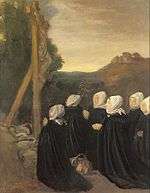Alphonse Legros
| Alphonse Legros | |
|---|---|
 Photograph of Legros by David Wilkie Wynfield | |
| Born |
8 May 1837 Dijon |
| Died | 11 December 1911 (aged 74) |
| Nationality | French, British |
| Education | Maître Nicolardo, Cambon, Lecoq de Boisbaudran |
Alphonse Legros (8 May 1837 – 8 December 1911) was a French painter, etcher, sculptor, and medallist.[1]
Life
Legros was born in Dijon; his father was an accountant, and came from the neighbouring village of Véronnes. While young, Legros visited the farms of his relatives, and the peasants and landscapes of that part of France are the subjects of many of his works. He was sent to the art school at Dijon with a view to qualifying for a trade, and was apprenticed to Maître Nicolardo, house decorator and painter of images. In 1851, Legros left for Paris to take another situation; but passing through Lyon he worked for six months as journeyman wall-painter under the decorator Beuchot, who was painting the chapel of Cardinal Bonald in the cathedral.
In Paris, Legros studied with Charles-Antoine Cambon, scene-painter and decorator of theatres. He attended also the drawing-school of Lecoq de Boisbaudran (the "Petite école") where he found himself in sympathy with Jules Dalou and Auguste Rodin. In 1855, he attended the evening classes of the École des Beaux Arts.

Legros sent two portraits to the Paris Salon of 1857: one was rejected, and formed part of the exhibition of protest organized by François Bonvin in his studio; the other, which was accepted, was a profile portrait of his father. This work was presented to the museum at Tours by the artist when his friend Jean Charles Cazin was curator. Champfleury saw the work in the Salon, and sought out the artist to enlist him in the "Realists," a group round Gustave Courbet.
In 1859, Legros's L'Angelus was exhibited, the first of the church interiors for which he was best known. Ex Voto (1861), went the museum at Dijon, but only obtained a mention at the Salon. He moved to England in 1863 and in 1864 married Rrances Rosetta Hodgson. At first he lived by his etching and teaching. He then became teacher of etching at the South Kensington School of Art, and in 1876 Slade Professor at University College, London in succession to Edward Poynter.[2]
.jpg)
Legros was naturalized as a British citizen in 1881, and remained at University College for 17 years. He would draw or paint a torso or a head for the students in an hour or less; in the painting school he insisted on a good outline, preserved by a thin rub in of umber, and then the work was to be finished in a single painting.
.jpg)
Legros picked up the art of etching by watching a college in Paris working at a commercial engraving, and taught himself the making of medals. He considered the traditional journey to Italy an important part of artistic training, he gave part of his salary to augment the income available for a travelling studentship. He died in Watford.
Works
Later works, after Legros resigned his professorship in 1892, returned to the manner of his early days—imaginative landscapes, castles in Spain, and farms in Burgundy, etchings such the series of The Triumph of Death, and the sculptured fountains for the gardens of the Duke of Portland at Welbeck Abbey. Pictures, drawings and etchings by Legros, went to the following galleries and museums:

- "Amende Honorable," "Dead Christ," bronzes, medals and twenty-two drawings, in the Luxembourg, Paris
- "Landscape," "Study of a Head," and portraits of Browning, Burne-Jones, Cassel, Huxley and Marshall, at the Victoria and Albert Museum, Kensington
- "Femmes en prière" (Tate, London)
- "The Tinker," and six other works from the lonides Collection, bequeathed to South Kensington
- "Christening," "Barricade," "The Poor at Meat," two portraits and several drawings and etchings, collection of Lord Carlisle
- "Two Priests at the Organ," "Landscape" and etchings, collection of Rev. Stopford Brooke
- "Head of a Priest," collection of Mr Vereker Hamilton
- "The Weed-burner," some sculpture and a large collection of etchings and drawings, Mr Guy Knowles
- "Psyche," collection of Mr L W Hudson
- "Snow Scene," collection of George Frederic Watts RA
- thirty-five drawings and etchings, the Print Room, British Museum
- "Jacob's Dream" and twelve drawings of the antique, Cambridge
- "St Jerome," two studies of heads and some drawings, Manchester
- "The Pilgrimage" and "Study made before the Class" (Walker Art Gallery, Liverpool)
- "Study of Heads," Peel Pan Museum, Salford.
- "Portrait of Cardinal With Patron Saint"(oil painting), Snite Museum of Art, Notre Dame University
References
- ↑ Legros, Alphonse in: L. Forrer: Biographical Dictionary of Medallists, Volume III, London 1907, p. 375-378.
- ↑ "Legros, Alphonse". Who's Who. 1911. p. 1193.
- Attribution
-
 This article incorporates text from a publication now in the public domain: Chisholm, Hugh, ed. (1911). "Legros, Alphonse". Encyclopædia Britannica. 16 (11th ed.). Cambridge University Press.
This article incorporates text from a publication now in the public domain: Chisholm, Hugh, ed. (1911). "Legros, Alphonse". Encyclopædia Britannica. 16 (11th ed.). Cambridge University Press.
Further reading
 Holroyd, Charles (1912). "Legros, Alphonse". In Lee, Sidney. Dictionary of National Biography, 1912 supplement. London: Smith, Elder & Co.
Holroyd, Charles (1912). "Legros, Alphonse". In Lee, Sidney. Dictionary of National Biography, 1912 supplement. London: Smith, Elder & Co. - Dr Hans W Singer, "Alphonse Legros," Die graphischen Künste (1898);
- Léonce Bénédite, "Alphonse Legros," Revue d'an (Paris, 1900);
- Cosmo Monkhouse, 'Professor Legros', Magazine of Art (1882).
External links
| Wikimedia Commons has media related to Alphonse Legros. |
- The Boston Public Library's Alphonse Legros set on Flickr.com
- Alphonse Legros exhibition catalogs
- Alphonse Legros in American public collections, on the French Sculpture Census website
